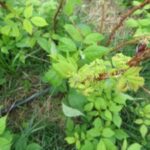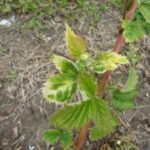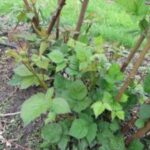Mesotrione is a Group 27 (HPPD-inhibitor) herbicide. It is registered as a stand-alone active ingredient in products such as Callisto®, Argos®, and Tenacity® among several others. It is also a common ingredient in pre-mix corn herbicides such as Acuron, Calliso® GT, Optero®, Storen® and many others. Mesotrione has both pre-emergence and post-emergence activity on select broadleaf weeds and some grasses. Because mesotrione indirectly inhibits the production of carotenoids (a pigment in plant leaves), susceptible plants typically turn white. This “bleaching” injury is often followed by plant tissue death (necrosis).
Callisto has been labeled for blueberries for just under a decade, but the label was expanded in 2016 to include brambles. At that time, Dr. Bruce Bordelon applied 3 fl. oz. per acre of Callisto to the bramble plantings at the Meigs Horticulture Research Farm in Lafayette, IN and reported significant damage on several varieties of blackberries and raspberries (Figures 1-4). The floricanes appeared to be more heavily damaged than primocanes, and in some cases, the damage was so severe that a complete loss of the summer crop was expected.
Since that time, additional research has confirmed Dr. Bordelon’s findings. Scientists in Arkansas (Knepp 2022) applied 4.5 or 9 fl. oz per acre of Callisto to greenhouse pots one day before transplanting ‘Ouachita’ blackberry plugs into them. Injury was reported by 7 days after treatment and increased progressively through the 42-day trial, resulting in 78 to 90% crop injury (on a scale where 0% is a completely healthy plant and 100% is a dead plant). Plants treated with mesotrione were shorter with shorter internodes, had fewer leaves, and less leaf chlorophyl. The same research group applied mesotrione to newly transplanted blackberry plugs in a field setting and reported that the plants were significantly damaged and did not fully recover, even by 84 days after treatment (Bertucci 2022).
The current label for Callisto restricts its use in cane berries and high bush blueberries to a post-directed spray prior to blooming. Post-directed applications generally target small, emerged weeds and the spray pattern is directed at the base of the crop with an effort to limit exposure of the crop to the spray. This can be difficult in caneberries depending upon the timing of primocane emergence and the presence of suckers. If you do decide to use Callisto for weed management in blackberries or raspberries, exercise caution.
References:
Bertucci, M. 2022. Evaluation of preemergent herbicides for newly planted blackberries. Southern Region Small Fruit Consortium Report. Available at 2022-R-06-progress.pdf (smallfruits.org) Accessed May 8, 2024.
Bordelon, B. 2016. Callisto herbicide injury in brambles. Facts for Fancy Fruit 16:4/ Available at Callisto Herbicide Injury to Brambles | Purdue University Facts for Fancy Fruit Accessed May 8, 2024.
Knepp, K. 2022. In-field and Greenhouse Assessments of Selection of Preemergence Herbicides on Newly Planted Blackberries. MS Thesis: University of Arkansas. Available at In-Field and Greenhouse Assessments of a Selection of Preemergent Herbicides on Newly Planted Blackberries – ProQuest Accessed May 8, 2024.
- Mesotrione damage on Heritage red raspberry. Photo credit Bruce Bordelon
- Mesotrione damage on thornless blackberry floricane foilage. Photo credit Bruce Bordelon
- Mesotrione damage on thornless blackberry floricane foilage. Photo credit Bruce Bordelon
- Normal thornless blackberry primocane growth. Photo credit Bruce Bordelon



